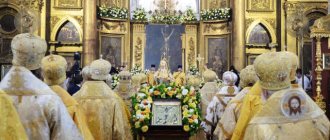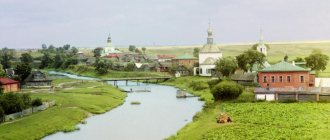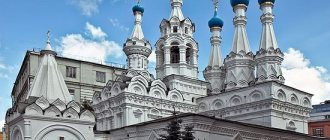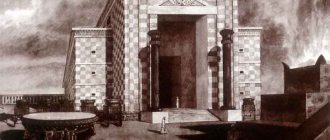Wooden architecture in Russia
Reaches its greatest prosperity in the 15th-18th centuries. Wooden temple construction prevailed in the northern regions of the country. This is explained:
- remoteness from the center and large industrial areas, in which stone construction predominated;
- inaccessible to the Mongol-Tatars;
- the absence of serfdom in the 18-19 centuries;
- the presence of extensive forests.
Wooden church in the name of the Holy Life-Giving Trinity in Korolev
Until the mid-19th century, wood remained the most common building material in Russia. Mastery in this area reached incredible heights. Several main types (or types) of wooden religious buildings were common.
Kletskaya Church
Most similar in appearance to residential buildings, huts. It has a rectangular frame, most often a gable roof. Although there are also four- and eight-slope endings. Representatives of this group:
- Church of Dmitry of Thessalonica, Staraya Ladoga, Leningrad region;
- Spasskaya Church from the village of Fominskoye, museum in Kostroma;
- Vvedenskaya Church, Osinovo, Arkhangelsk region;
- Church of St. George the Victorious (1493), Rodionovo (Yuksovichi), Leningrad region;
- Kazan Church, Taltsy, Irkutsk region;
- Church of the Resurrection, Neklyudovo (Bor), Nizhny Novgorod region;
- Church of St. Andrew the First-Called, Solovki, Arkhangelsk region.
St. Andrew's Skete of the Solovetsky Monastery
The cage type prevailed in Russian wooden architecture. Although it was similar to domestic buildings, it was fundamentally different from them in its vertical orientation, pointed tops, and expressive forms.
Tent Church
Temples, the central part of which, instead of a dome, is covered with an architectural structure in the form of a multifaceted pyramid, belong to tent architecture. This shape apparently arose due to the fact that it is difficult to build domes from wood. The design of the tent in this case is much simpler.
The most common option is a frame of 6-8 vertically stacked logs, with the upper ends converging upward. The following have survived to this day:
- Church of St. Nicholas the Wonderworker, Novinki village, Vologda region;
- St. George's Church, from the village of Vershina, Malye Korely, Arkhangelsk region;
- Nativity Church, Yakovlevskaya village, Zaostrovye, Arkhangelsk region;
- Assumption Church, Varzuga, Murmansk region;
- Resurrection Church from the village of Potakino, museum in Suzdal, Vladimir region;
- Church of the Archangel Michael, Yuroma, Arkhangelsk region.
Wooden tented Assumption Church in Karelia
Tent temples largely determined the appearance of ancient Russian cities and villages. The elongated, pillar-shaped silhouettes of churches looked contrasting against the background of domestic buildings. Wooden tented churches are also popular in modern Russia, where they are especially popular.
Tiered Church
Temples of this type began to be built from the end of the 17th century. Their design consists of log houses, quadruples or octagons, stacked on top of each other, decreasing towards the top. As a rule, such temples are crowned with one chapter. They can be considered using an example:
- Church of St. John the Theologian of the 17th century, the village of Bogoslovo on the Ishna River, Yaroslavl region;
- Tikhvin Church in Torzhok;
- St. Nicholas Church, Vysoky Ostrov village, Novgorod region, Vitoslavlitsy museum;
- Transfiguration Church (1756), Kozlyatevo village, Vladimir region;
- Church of the Cathedral of the Virgin Mary (1552), village of Kholm, Kostroma region;
- Church of John the Baptist (1694), Shirkov churchyard.
Church of the Nativity of John the Baptist, Shirkov Pogost
Wooden tiered churches are found mainly in the central part of Russia.
Cubic Church
The time and place of distribution of such temples was the mid-17th to late 18th centuries, the White Sea coast and Poonezhie. The design is based on a naos, covered with a cube on top, usually ending with 5 or 9 chapters. The most famous of the cubic temples that have survived to this day are:
- Church of St. Paraskevi (1666), village of Shuya, Arkhangelsk region;
- St. Nicholas Church in the village of Conception near Kholmogory;
- Church of the Ascension (1669), village of Kushereka, Arkhangelsk region.
Church of the Ascension in Onega region
Sometimes the architectural type includes temples, the completion of which is built in a cubic form.
Domed church
Religious buildings of this type are characterized by roofs formed by hexagons or octahedrons stretched upward like an onion. Here are some of them:
- Church of the Nativity of the Virgin Mary (1808), village of Zayacherichye, Vologda region;
- Church of St. Nicholas (19th century), village of Zayacherichye, Vologda region;
- Vvedenskaya Church, Boriskovo village, Ryazan region.
Churches with domes were common in the 18th and 19th centuries. in Povazhye, on the banks of the Vaga River in the Arkhangelsk and Vologda regions, as well as in Siberia and Ukraine.
Multi-domed church
Temples with more than five chapters became a striking event in Russian architecture. This was the last, final stage of wooden temple construction. It is based on a multi-tiered composition and an octagon with 4 cuts.
- Church of the Intercession, Kizhi Pogost;
- St. Basil's Church (1657), Chukhcherma village, Arkhangelsk region;;
- Transfiguration Church, Kizhi;
- Church of the Intercession of the Blessed Virgin Mary (1708-1963), recreated in the Nevsky Forest Park.
Church of the Intercession in Nevsky Forest Park
Old Russian churches, despite their small size, created the impression of monumentality, grandeur, and representativeness.
Wooden temples of Rus'
Wood is a short-lived building material and is also highly flammable. Therefore, very few ancient monuments of wooden architecture have survived to this day. We know about the existence of some temples exclusively from chronicles: the Assumption Cathedral in Rostov (992), St. Sophia Cathedral in Novgorod (989), others. But there are also those that have survived to this day.
The oldest wooden church in Russia
One of the oldest examples of Russian wooden architecture that has survived to this day is a small wooden church built in the village of Borodava in 1485, near the Ferapontov Monastery (23 km), and named in honor of the holiday of the Position of the Venerable Robe of the Mother of God in Blachernae.
Church of the Placing of the Robe from the village of Borodava
In 1957-58 was moved to the city of Kirillov during the construction of the Volga-Baltic waterway (it fell into the flood zone), and is now located in the Kirillo-Belozersky Monastery.
Wooden temple without a single nail
As an ancient legend says, the Church of the Transfiguration of the Lord (1714) on the island of Kizhi was built by a master named Nestor with only an ax, without a single nail. The temple has an octagonal frame at its base, topped with 22 domes.
Church of the Transfiguration of the Lord on Kizhi Island
In 1990 it was included in the UNESCO World Heritage List, and a few years later - in the list of the most valuable cultural heritage of the peoples of Russia.
Wooden Suzdal temple
Church of St. Nicholas (1766) in Suzdal - another example of carpentry, was built without the use of nails. Transported to the city in 1960 from the village of Glotovo, Vladimir region, and restored by architect M. M. Sharonov. The move was motivated by the preservation of the monument and the development of Suzdal as a tourist center.
St. Nicholas Church on the territory of the Suzdal Kremlin
Wooden churches in Moscow
The first churches of the capital of the Russian state were wooden and short-lived. Therefore, they have hardly survived to this day. Subsequently, Moscow continued to erect mainly stone buildings. At the end of the 20th century, church life in the capital revived, and the city continues to be built up with churches. Among them are many wooden temples:
- temple of st. Tikhon of Zadonsky (1863), Sokolniki metro station;
- Church of the Transfiguration (19th century), Bogorodsky district, st. Krasnobogatyrskaya 17;
- temple in honor of the Sovereign Icon of the Mother of God (1995), near the station. Kropotkinskaya metro station;
- Church of the Great Martyr George the Victorious (1997) in Koptevo, Voikovskaya metro station;
Church of the Holy Great Martyr George the Victorious in Koptevo - Holy Cross Chapel (1996), Krasnopresnenskoye metro station;
- Church of the Annunciation of the Blessed Virgin Mary (1997) in Raevo, Babushkinskaya metro station;
- church-chapel of St. Vmch. Vladimir Metropolitan of Kyiv and Galicia (1997), Sviblovo metro station;
- church-chapel of St. Nikolay, st. Eliseiskaya, 22;
- temple in honor of the icon of the Mother of God “Quench my sorrows”, Medvedkovo metro station;
- Church of Alexy Metropolitan of Moscow (1998), Northern Medvedkovo;
- Chapel of Rev. Sergius of Radonezh, intersection of Norilskaya and Malygina streets;
- Church of the New Martyrs and Confessors of Russia, Butovo;
- Church of St. Dimitry Donskoy, Gardeners;
Church of St. Demetrius Donskoy in Sadovniki, Moscow - chapel of St. Nikolay, st. Kargopolskaya, Otradnoye metro station.
This is not a complete list of all wooden churches in Moscow. In such churches it is especially easy to breathe and pray; the interior is a very bright and cozy, calm place for parishioners.
Wooden churches in the Leningrad region
In the village of Rodionovo, in the Podporozhsky district of the Leningrad region, on the shore of the lake, the courtyard of the Alexander-Svirsky Monastery is located. Monks live here all year round; in the summer there is an Orthodox children's camp.
Nearby, on the same bank, stands the St. George Church, built almost 500 years ago. This is one of the oldest operating wooden churches in Russia. The building has minimal decoration, but it is elegant - its craftsmen had a subtle sense of beauty.
Church of St. George the Victorious in the Leningrad region
Resurrection Church in the village of Vazhiny, Podporozhye district. It was built in 1630. Originally a hipped structure, ten-sided, it was rebuilt in the 19th century. Therefore, its appearance combines the forms of an ancient wooden temple with the features of modern architecture. The only wooden temple that has survived to this day and has a decahedron at its base.
Among the new, modern projects is a wooden church built by Mikhail Krasovsky in the holiday village of Vyritsy. Today it is one of the most visited churches in the Leningrad region. Such a large flow of people coming here is associated with one of the main shrines, the grave, the resting place of St. Seraphim Vyritsky.
Temple of the Kazan Icon of the Mother of God, Vyritsa
The oldest wooden church in Russia
Vladimir Stanulevich, Summer Guide of REGNUM Information Agency, May 29, 2021, 07:30 — REGNUM Lyavlya is not only a beautiful place on the slopes of a wide ravine where a river flows, but also a significant historical place in the Russian North. Here, in the 14th century, the Novgorod mayor Anastasia founded the Assumption Monastery . It is one of the oldest, if not the oldest, in the Arkhangelsk region. In 1340, the Grand Duke of Moscow Ivan I Kalita granted the monastery the Gospel, which was later named Siysky after the name of the monastery in whose library it was kept. Or the Siysk Gospel of 1340, since there is a second, magnificent Siysk Gospel of 1693.
Lyavlya - a historical place of the Russian North
Vladimir Stanulevich © REGNUM news agency
The Assumption Monastery was founded here in the 14th century.
Vladimir Stanulevich © REGNUM news agency
The only building left from it is the St. Nicholas wooden church.
Vladimir Stanulevich © REGNUM news agency
It was built in 1584 and is the same age as Arkhangelsk
Vladimir Stanulevich © REGNUM news agency
St. Nicholas Church was built according to the classic scheme for the North - a tent on an octagon, an octagon on a quadrangle
Vladimir Stanulevich © REGNUM news agency
The Gospel-aprakos of 1340 is the oldest Moscow manuscript, the size of a sheet, written on parchment with a direct charter and decorated with one headpiece and two miniatures. One miniature depicts the worship of the Magi to the Mother of God, the second - Christ with the apostles.
The Gospel preserved the names of the scribes, the clerks Melentius and Prokosha, and the artist, who left his name in the inscription on the ornament: “Lord, help the much-sinful John to write the zastavitsa sik.” The manuscript contains a monthly book, where the months, in addition to the now modern Roman names, also have Slavic names - ruin, leaf fall, cold, etc. On the last page the author reports that the manuscript was written in 6847 “in the city of Moscow”, “by command of a servant of God Anania the Chernets” - the Moscow Grand Duke Ivan Kalita, who took monastic vows in the last year of his life and went “to the Dvina to the Holy Mother of God.”
The church, according to legend, was erected on the site of the grave of the brother of the Novgorod mayor Anastasia Stefan
Vladimir Stanulevich © REGNUM news agency
The half-erased words above the entrance to the church say this
Vladimir Stanulevich © REGNUM news agency
These words can no longer be understood
Vladimir Stanulevich © REGNUM news agency
The logs of the temple were so rotten in the 19th century that they decided to dismantle the temple.
Vladimir Stanulevich © REGNUM news agency
When the Lyavlensky Monastery was assigned to the Anthony-Siya Monastery in 1633, the Gospel was taken to Siya. The transfer of the monastery to the power of Siya was accompanied by a scandal. In 1632, a priest from Nenoksa, Pavel Kochurov, asked Tsar Mikhail Fedorovich for a letter of permission to serve him in Lyavla in a church that was supposedly empty. He hid the fact that there was a monastery here and kicked out the brethren. The abbot of the monastery, Job, and the brethren turned to the tsar that “Priest Paul took the letter of service falsely,” and now the elders “walk between the courtyards, dying of hunger, and there is no one to come to repentance and bury.” The elders asked to send a monk from the Siysk Monastery to help them, and “not to order priest Paul to be with them.” So Lyavlya became the patrimony of the Siya monastery.
There are 70 icons in the iconostasis of the Assumption Church in Lyavle
Vladimir Stanulevich © REGNUM news agency
Belfry of the Assumption Church
Vladimir Stanulevich © REGNUM news agency
Dome of the Assumption Church in Lyavle
Vladimir Stanulevich © REGNUM news agency
Near the wooden one is the Assumption Stone Church, built in 1894.
Vladimir Stanulevich © REGNUM news agency
From the bell tower you can see the entire Lyavlinskoe tract. On its opposite bank is the Lyavlensky St. John the Theological Convent, founded in 1994
Vladimir Stanulevich © REGNUM news agency
Memorial cross at the site of the founding of the Lyavlensky Monastery
Vladimir Stanulevich © REGNUM news agency
The only building remaining from the ancient monastery is the St. Nicholas Church built in 1584. This is the oldest wooden temple in Russia. Another story is connected with the St. Nicholas Church, under which, according to legend, there is the grave of Posadnitsa’s brother Stefan, by 1844 it had fallen into disrepair and was about to be demolished. The temple was visited by the Arkhangelsk military governor Marquis Traverse and decided to repair it at his own expense. One can speculate about the reasons for this decision; they said that the reason for it was the illness of his son and the vision of the marquis’s wife that his son would recover if the church in Lyavle was repaired.
View of the Lyavlinsky tract from Ioannovsky Monastery
Vladimir Stanulevich © REGNUM news agency
The main temple of the convent is St. John the Theologian
Vladimir Stanulevich © REGNUM news agency
Under Soviet rule, the church was a branch of a Gulag transit camp and a military unit warehouse. Now the church is on the balance sheet of the Malye Korely Museum of Wooden Architecture, and judging by its deteriorating condition, the museum does not have enough funds for its restoration and even emergency work.
Church of the New Martyrs and Confessors of Russia
Vladimir Stanulevich © REGNUM news agency
In the monastery garden in the center of the courtyard, the sister nuns grow potatoes, tomatoes, cucumbers, onions, garlic - everything they need for the table
Vladimir Stanulevich © REGNUM news agency
Read earlier in this story: He wanted to stop the catastrophe of the Russian people
Wooden churches of the Russian north
In the Russian North you can see many beautiful wooden churches. Ancient architects, having neither nails nor hammers, erected structures of incredible beauty. Most of the ancient churches have not survived. But some of them, dating back to the beginning of the 18th century, managed to miraculously survive.
Kizhi Pogost
The architectural ensemble is located on one of the islands of Lake Onega in Karelia. Includes the pearl of Russian wooden architecture - the 22-domed Church of the Transfiguration. Its unusual design provided an effective ventilation system, which ultimately helped save the building from destruction. The church is made entirely of wood, without nails.
Church of the Resurrection of Lazarus in Kizhi, Karelia
In the second half of the 19th century, other wooden churches from different places in Karelia were moved to the island in order to preserve them. This is how an open-air museum was formed.
Church of All Saints in Surgut
The temple in the name of all the saints who shone in the land of Siberia was restored without a single nail, according to all the rules of church wooden architecture in 2002 on the very spot where the first Church of the Nativity of the Blessed Virgin Mary, built by the Cossacks, was located.
Church of All Saints who shone forth in the Siberian Land, Surgut
Combines ancient and modern traditions and technical techniques in architecture. There are features of cage and tent architecture. The design of the temple can be described as an “octagon on a quadrangle.” The frame is crowned with a hipped bell tower.
Churches, chapels. historical reference
, the construction of wooden churches and chapels has been widespread in Russia . This was explained by the fact that wood is a relatively accessible and inexpensive material. The temples were distinguished by such completeness of architectural forms that many elements were subsequently tried to be repeated in stone architecture.
In the early 90s, despite some chaos in the country, church life revived, the construction of small churches began in small areas that were supposed to fit into the surrounding landscape, this is another reason why the construction of churches and chapels is in demand from such material as tree.
The need for the construction of wooden churches is great. If before the revolution there were 65 thousand churches in Russia, now there are only 29 thousand, including Orthodox churches abroad. There are approximately 150 thousand settlements in Russia. That is, there is one temple for 5-7 settlements. Residents of many villages are forced to travel to cities for services. Over the past 20 years, about 19 thousand churches have been built in Russia. But this is not enough!











